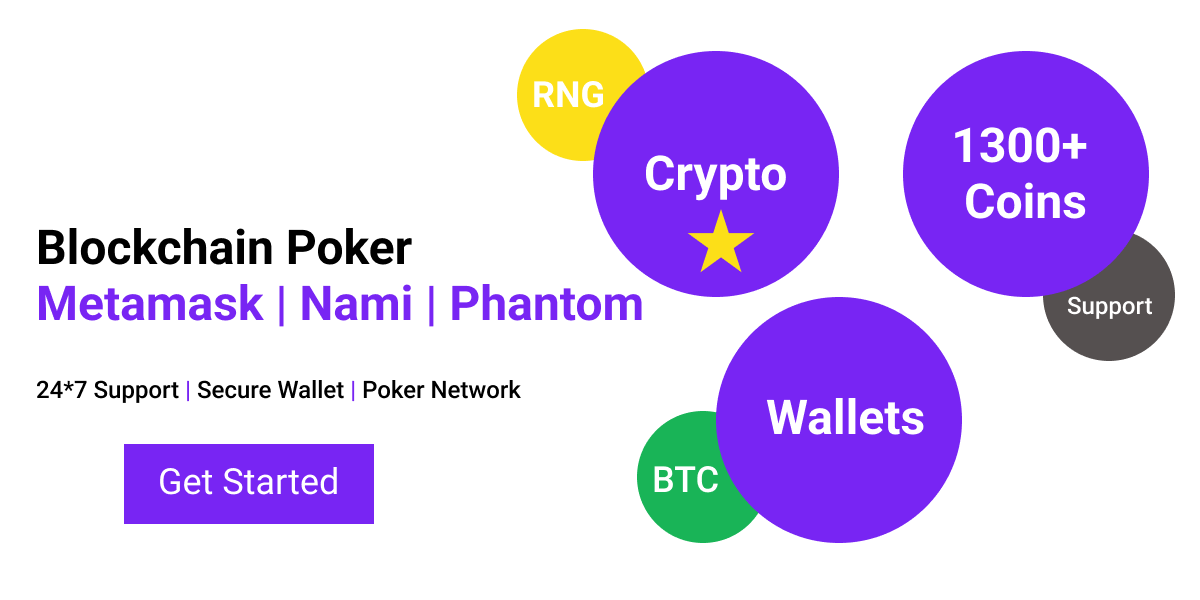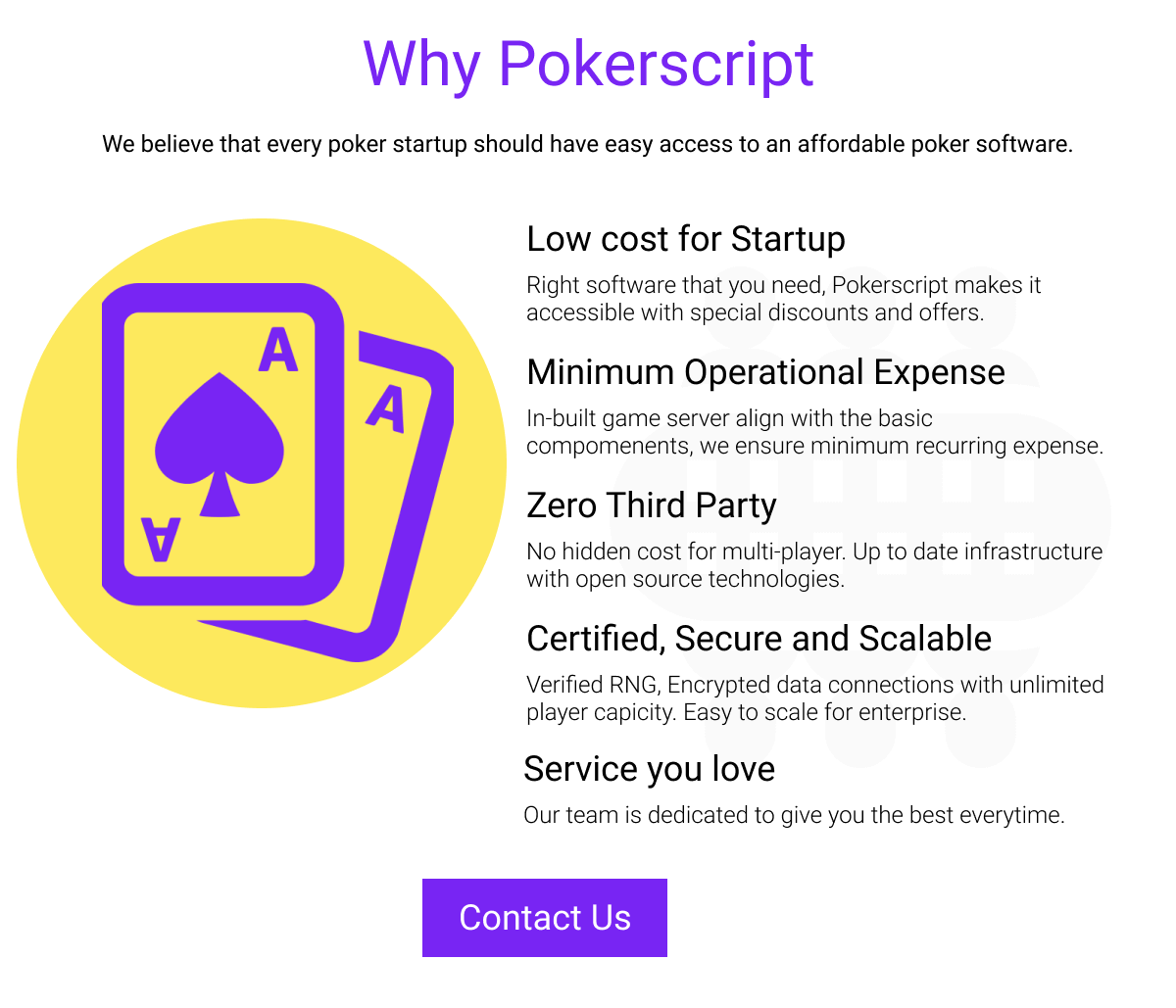Blockchain poker is a decentralized poker solution built on blockchain technology, that accepts crypto payments, and uses a P2P card shuffling methodology with Cryptographically secured RNG for absolute randomization. In web3 poker, each table transaction like chips transactions, and players' chats and hand histories are recorded on a blockchain network with become immutable and provides transparency among players.
In our blockchain poker, we have used decentralized wallets (Metamask, Fantom & Nami ), decentralized data storage ( IPFS + Filecoin, Swarm, Sia & Storj ) decentralized Identity solitons (ENS & Magic Link), and smart contract networks like Ethereum, Polygon, and Binance Smart Chain to enhance the entire gaming experience to keep the trust and fairness at high-level. This whole practice comes into a widely in -discussion emerging technical topic called web3 technology. Let's explore how this web3 technology works behind a web3 poker solution.
What is web3 technology?
Web3 technology is a technical evolution, a modern ecosystem that works on a decentralized concept upon serverless internet setup. Each user is capable to control their own profile data, access, identity, and destiny. It uses distributed ledger technologies (DLT) with blockchain protocols, highly focused on cryptographic methods to ensure the security and stability of the web3 ecosystem. Poker is the first multiplayer game that is using this web3 technology by creating blockchain poker for its players. Poker developers are not keen to build things from zero, instead, they use open-source blockchain resources and networks to deliver a super quality poker software.
To explain this web3 technology, it is good to divide the whole web3 tech stack into multiple micro-level components, usually called layers.
Layer 0
This is the bottom layer of this web3 technology that talks about the OSI model and focuses on the integration between blockchain and networks. It does not change the blockchain structure and maintains its original ecosystem rules for performance and scalability improvements. In short, we also say this as the network transport layer.
(1)- P2P internet overlay protocols
These protocols provide the discovery of other users and participants over the internet as well as provide the guidelines for secure communications among the participants.
In short, this is a modular system of protocols, libraries, and guidelines that enable the product development of peer-to-peer network applications.
For example;
-
Devp2p (Used by Ethereum)
-
BLibp2p (Open to adopting any p2p Application)
(2)- Platform-neutral computation description language
This part works like a huge decentralized or genesis computer to process all types of tasks over the blockchain. It creates a relation between the executing the code and the machines to improve the software probability with a sense to keep applications separated from each other and at the same time separated from their native host. Usually, all smart contract deployment and execution reside here.
For example;
-
EVM - Ethereum Virtual Machine ( Ecosystem where Ethereum accounts and smart contracts live )WASM - WebAssembly ( Stack-based virtual machine supporting binary instructions )UTXO - Unspent Transaction Output ( Ensure process independently and in parallel keeping upsent outputs as input to a transaction )
In blockchain poker, the development team has nothing to do with this layer. This layer is important to create a brand new genesis blockchain. Most of the web3 poker is based on open-to-use available pre-built and community-supported networks like Ethereum, Polygon, and BSC. For some, clients we have used open-source private chains like Hyperledger with custom controls over data and privacy.
Layer 1
This is the core protocol for blockchain technology. This layer concludes the distribution and interaction align with the data distribution, low-trust interaction platforms, and protocols. Overall this layer acts as infrastructure for the applications. The core consensus mechanism executes here based on the different mechanisms. The very popular mechanism proof of work and proof of stake are planned and executed on this layer. Layer 1 works as foundational networks which we call blockchain networks.
(1)-Data distribution protocols
This protocol plans and describes how the data must be distributed and shared among the different decentralized nodes on the blockchain. It can be a peer-to-peer distribution network or distributed storage platform to handle the in-chain transactions.
For example;
-
IPFS - Cryptographcly hashed with unique fingerprint identity called content Identifier (CID) decentralized server. If we choose a private blockchain to build our blockchain poker software, it becomes the core base for storage.Swarm - Peer-to-peer nodes for decentralized storage with a built-in reward system backed via smart contracts on Ethereum Chain.
(2)-Low-trust interaction platforms/protocols
These protocols basically focus on the nodes that connect to each other and interact with the computation trust and manage the information passing from each of them. Almost every cryptocurrency like Bitcoin, Ethereum, etc, works on this low trust interaction protocol to describe their rules that make based on any node that follows to execute within the protocol.
For example;
-
Bitcoin - Native decentralized digital coin that works on a peer-to-peer network. Blockchain poker uses this bitcoin as one currency for chip purchasing.Polkadot - Open source blockchain platform, that provides cross-blockchain data transfer and specialized in interpretability between blockchainsEthereum - Community managed web3 technology package with its own native token ‘Ethereum’.
(3)-Transient data messaging
This protocol set rules about the data storage which we have to keep permanently stored. Information like status updates is shared within nodes and makes them aware of the data presented.
For example;
-
Whisper - Flexible & secure communication protocol for Ethereum network keeping the user's anonymity.Matrix - Open standard, an application-layer communication protocol that replicates data overall server nodes.
Layer 2
This blockchain layer usually called second-layer protocols facilitates the capability enhancement for layer 1 by providing functionalities like highly-optimized scaling, deep-level message encryption, and advanced distributed computing. For example, this layer can create an ecosystem where it is not required to handle all transactions on the main chain. It is possible to keep node communication with each other off-chain by "Open" and "Close" updates on the main chain to record the final results. In the case of blockchain poker, it is highly recommended to keep to table transactions on the local network until the winning result is declared.
For example;
-
Bitcoin Lightning Network - Added to the core Bitcoin's blockchain to execute the off-chain transactions to increase the scalability.Ethereum Plasma - Child chain created to offload the transaction traffic on Ethereum with smaller copies of Ethereum Mainnet.
Layer 3
It includes different human-readable languages, libraries, and APIs that are required to create the programs. It's a composite of the bags of technology that a developer uses to build web3 applications as we do in our blockchain poker. Solidity is the right choice to write the smart contracts and web3 js for metamask integration. We also use Node js for the backend and web socket for API or data communications.
Protocol-extensible developer APIs & languages
Based on the foundations there are so many languages that a developer can use to write applications without deep level dealing with real bytecode, such as Solidity, Golang or Vyper for Ethereum, polygon (ERC Protocols), Rust for Solana, and Plutus for Cardano.
For example;
-
Web3.js - Javascript APIs and libraries that help to interact with the local and remote Ethereum nods via WebSocket or IPC on HTTP.Ether.js - Client-side javascript library to interact with Ethereum nodes, more focus on wallet security keeping the private key localization.Solidity - Curly-bracketed, object-oriented language, specially designed to write smart contracts for Ethereum Virtual Machine (EVM). Based on Python, C++, and Javascript.Rust - Community operated, general-purpose language majority included by Erlang, Haskell, C++, Cyclone, and OCaml.
Layer 4
This is the top layer of blockchain technology where the end-user gets an interface, to interact with one or multiple blockchains directly. There is no requirement for technical implementations as it provides an access facility for users as a tool to connect the respective blockchains. In blockchain poker, metamask is a highly demanded wallet from each region of the world. It makes things much easier to connect a web3 poker via a chrome browser instantly. Now, deposit and withdrawal is a two-click process that was not possible earlier.
Protocol-extensible user-interface cradle
This is a combination of communicating events and user interface using web3 technology. This technology does not need to process data from URL-encoded strings. Each UI request is rendered directly as incremental updates which enhance the speed and scale the network with high performance.
For example;
-
Metamask - #1 browser supported cryptocurrency web3 wallet target to Ethereum blockchain.Phantom - Browser-supported user-friendly wallet to store, buy, send and receive NFT and token on the Solana Blockchain.Nami - Multi-asset supported browser wallet to interact with Cardano Blockchain.
At poker script, the team has strong experience with these above-mentioned web3 wallets. In blockchain poker, the player connects his web3 wallet to get the system access instantly. These wallets function in different ways like providing unique identity keys for login, chip purchases, crypto transactions, etc.
How can I utilize my crypto-token in blockchain poker?
Web3 technology is the latest buzz in the gambling industry. The Crypto payment method cuts the lengthy procedure-based verifications and approvals for payment within blockchain based poker. The globally accepted single payment standard scales the business. Bitcoin, Ethereum, and Stablecoins like USDT provide a facility for users to connect and buy chips from any geographical location.
For your personal token, you can easy to integrate it as a payment method on your blockchain poker. It can be accessed either using web3 wallets like metamask or a manual deposit and withdrawal process using QR scanning or address base payment.
A player must have this token in his wallet as a balance to buy the chips. These purchased chips will be the in-game currency for game tables. There is another way to offer direct play with your token on real-time tables. I suggest not to use this method, because it may lower the table speed due to network confirmation for transactions. If you avoid making a local wallet then there is a problem with real-time price updates.
How web3.0 is changing the gaming industry?
The casino gaming industry is going through its most advanced evolution on the base of emerging blockchain technology. Credit goes to the ongoing legal acceptance and supports for gambling-related activities with global reach, which is making this business at its highest record-breaking revenue figures. As per the latest estimate, at the start of 2022, the market size for the online casino industry reached 350 billion U.S Dollars. Even small players are also getting substantial growth due to crypto wallet support for easy-to-process deposits and withdrawals. In blockchain poker, this Web 3.0 technology generally called web3 is adding huge value to its online poker players. It automates the whole process with more trusted transactions that were lacking in the previous online setup.
The gaming market always looks for a solution that works transparent, accurate, and trustable. Here, blockchain poker is fulfilling all these required parameters to be their first choice in the online poker business. Using a web wallet like metamask, it is so easy to buy chips and start playing games in minutes. As a player, I do not need to put my bank details, personal details, etc. The future of web3 poker is trending in a positive direction. As per the current move, I can say, the next decade will be for blockchain enabled poker only. People will discard the traditional poker sites for many reasons, and blockchain technology will be one of them.




